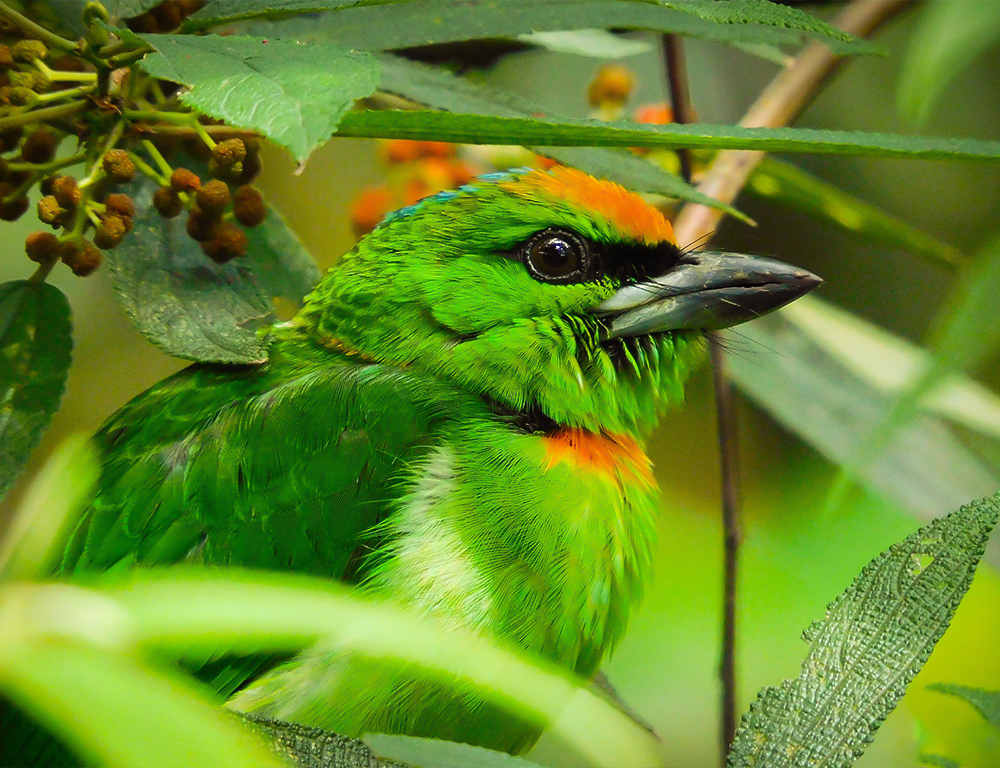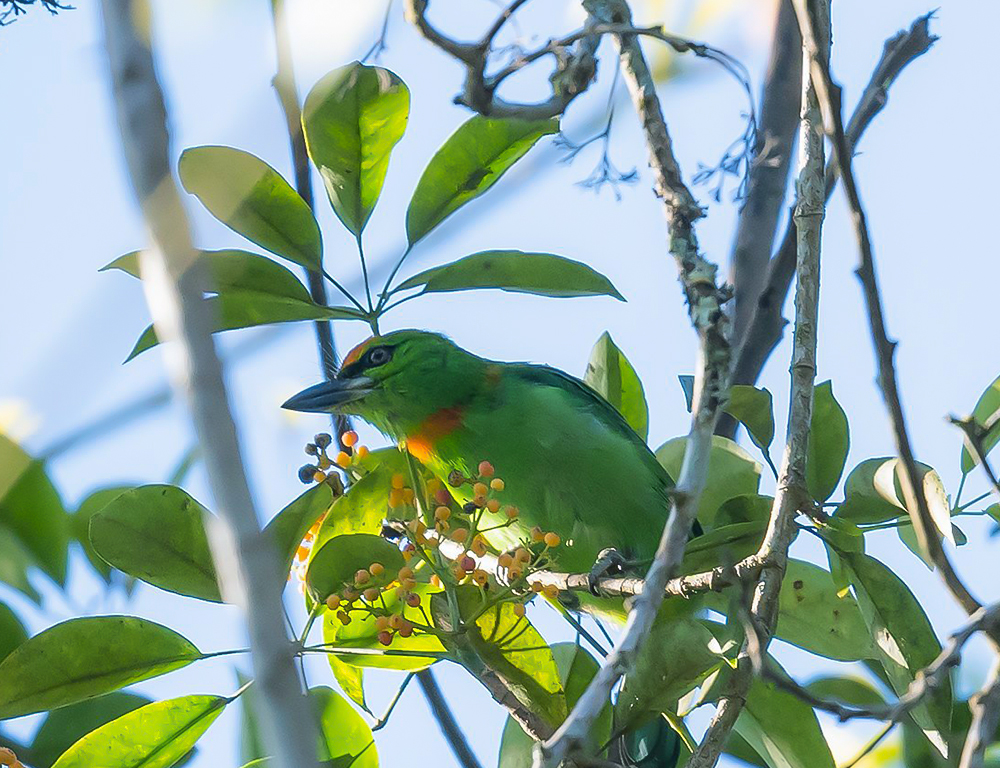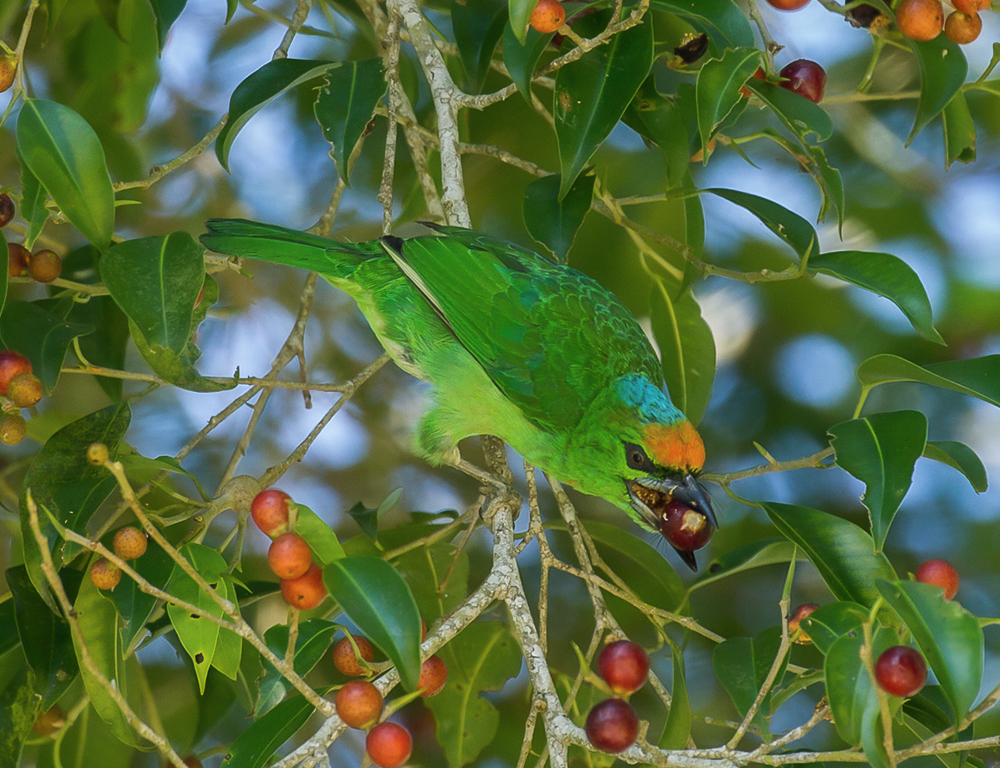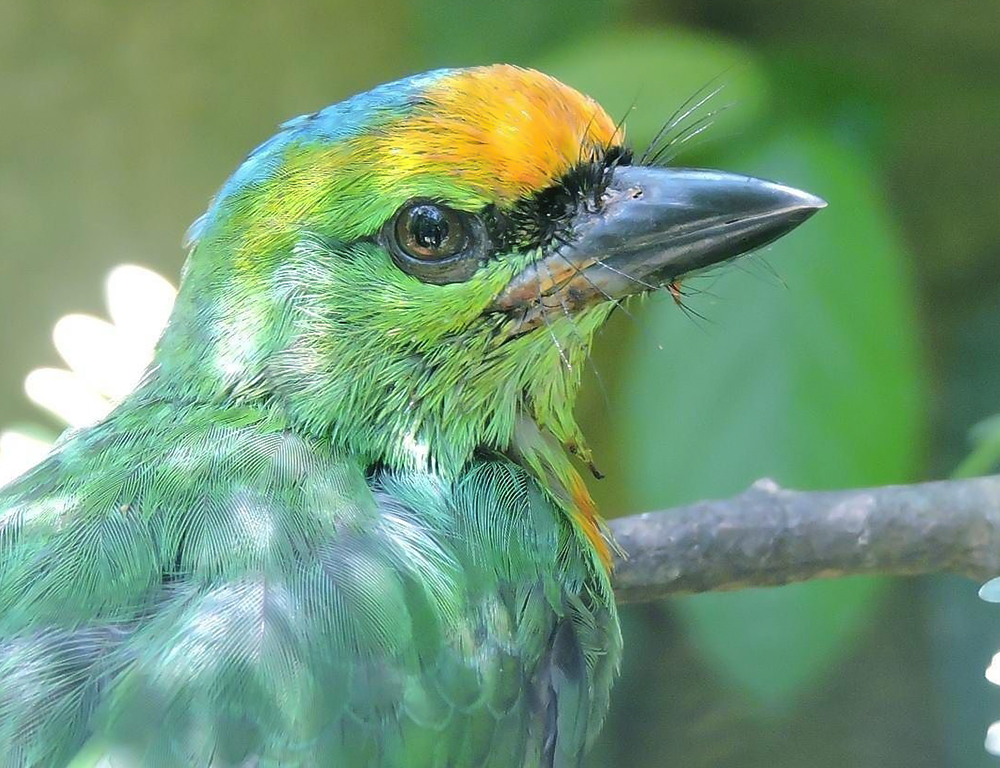The Flame-Fronted Barbet (Psilopogon armillaris) is a captivating bird species native to the lush forests of Southeast Asia, particularly Java and Bali in Indonesia.
Known for its vibrant plumage, featuring a striking yellow-orange forehead, blue nape, and an orange chest patch, this medium-sized bird stands out amidst its verdant surroundings.
With a diet primarily consisting of fruits and berries, it plays a crucial role in seed dispersal within its ecosystem. Its unique nesting behavior, where both males and females share incubation duties, underscores the species’ cooperative nature.
Despite its charismatic presence, the Flame-Fronted Barbet faces habitat loss and degradation threats due to deforestation and urbanization.
Understanding and conserving this remarkable avian species is essential for preserving its habitat’s biodiversity and ecological balance.
Physical Characteristics of Flame-Fronted Barbet

The Flame-fronted barbet (Psilopogon armillaris) possesses several distinctive physical characteristics that contribute to its striking appearance and make it easily recognizable in its natural habitat.
Here’s an overview of its physical traits:
Size
Flame-fronted barbets are medium-sized birds, measuring approximately 19.5–23 cm (7.7–9.1 inches) in length from beak to tail.
Plumage
The plumage of the Flame-fronted barbet is predominantly green, which aids in camouflaging it amidst the foliage of its forest habitat. However, the colorful patches on its head and chest make it stand out:
- Yellow-Orange Forehead: One of its most striking features is the vibrant yellow-orange coloration on its forehead, extending from the base of the bill to the crown.
- Blue Nape: Behind the yellow-orange forehead is a distinctive patch of blue on the nape of the bird’s neck.
- Orange Crescent on Chest: Another notable feature is the crescent-shaped orange patch on its chest, adding to its overall coloration.
Beak
Like other members of the barbet family, the Flame-fronted barbet has a stout, slightly curved beak adapted for feeding on fruits, berries, and insects.
Eyes
The bird’s eyes are typically dark, providing sharp vision for foraging and navigating its environment.
Tail
Its tail is short to medium, proportionate to its body size.
Legs and Feet
Flame-fronted barbets have sturdy legs and feet suited for perching and moving through the branches of trees within their forest habitat.
Habitat and Distribution of Flame-Fronted Barbet

The Flame-Fronted Barbet (Psilopogon armillaris) exhibits fascinating habitat preferences and a distinctive geographical distribution pattern.
Let’s delve deeper into these aspects:
Preferred Habitat
These vibrant birds thrive in diverse habitats, showcasing their adaptability. Here are some key points about their preferred habitat:
- Subtropical or Tropical Moist Lowland Forests: Flame-fronted barbets are commonly found in these lush forest environments, where they can forage for food and find suitable nesting sites.
- Heavily Degraded Former Forest Areas: Interestingly, they also inhabit areas that have experienced significant degradation, showcasing their ability to adapt to human-altered landscapes.
- Altitude Range: They prefer altitudes ranging from 200 to 1400 meters above sea level, indicating their versatility across different elevations.
- Nesting Behavior: Flame-fronted barbets nest in tree cavities, providing them privacy and protection from potential threats while raising their young.
Geographical Distribution
The Flame-Fronted Barbet’s distribution spans Indonesia and Malaysia, with notable concentrations in specific regions.
Here’s a breakdown of their estimated population distribution:
- Indonesia: Approximately 60% of the Flame-Fronted Barbet population is found within Indonesia, reflecting a significant presence in this country.
- Malaysia: About 30% of the population resides in Malaysia, indicating a substantial but relatively minor presence compared to Indonesia.
- Borneo and Sumatra: Specific concentrations of Flame-Fronted Barbets are observed in regions like Borneo (7%) and Sumatra (3%), highlighting the importance of these areas for the species’ survival.
Conservation Concerns
Despite their relatively widespread distribution within these regions, the Flame-Fronted Barbet faces threats from habitat changes, mainly due to deforestation practices.
Their moderately small global range underscores the importance of conservation efforts to protect their habitats and ensure their continued survival in the face of environmental challenges.
Diet and Feeding Habits of Flame-Fronted Barbet

The Flame-Fronted Barbet (Psilopogon armillaris) showcases fascinating dietary preferences and feeding habits, reflecting its role as an omnivorous bird within its ecosystem.
Here’s a closer look at its diet and feeding behaviors:
Diet
Flame-fronted barbets have a varied diet that includes a mix of fruits, berries, insects, and occasionally small vertebrates. Their flexible dietary habits allow them to exploit various food resources in their forest habitat.
Key components of their diet include:
- Fruits and Berries: They feed extensively on various fruits and berries, essential energy, and nutrient sources. Ripe fruits from forest trees and shrubs are particularly favored.
- Insects: In addition to fruits, Flame-Fronted Barbets consume many insects, including beetles, ants, caterpillars, and other arthropods. They may glean insects from foliage or catch them in mid-air during foraging flights.
- Small Vertebrates: While less common, Flame-Fronted Barbets may occasionally prey on small vertebrates such as lizards, frogs, and even small birds, supplementing their diet with animal protein.
Feeding Habits
The Flame-Fronted Barbet employs various feeding strategies to acquire its diverse diet, exhibiting behaviors adapted to its foraging needs and ecological niche.
Some notable feeding habits include:
- Fruit Foraging: Flame-fronted barbets may pluck fruits directly from trees or shrubs using their strong beaks when feeding on fruits and berries. They may also swallow fruits whole or manipulate them to extract seeds or pulp.
- Insect Gleaning: To capture insects, Flame-Fronted Barbets employ a technique known as gleaning, where they carefully inspect leaves, branches, and other surfaces for small arthropods. They use their agile beaks to pick off insects from foliage or bark.
- Hawking: Besides gleaning, Flame-Fronted Barbets may engage in hawking, catching flying insects in mid-air using their quick reflexes and agile flight maneuvers.
- Hunting: When targeting small vertebrates, Flame-Fronted Barbets may stalk their prey from perches within the forest canopy, then swoop down to capture their quarry with a swift strike of their beaks.
Reproduction and Nesting of Flame-Fronted Barbet
The Flame-fronted barbet (Psilopogon armillaris) exhibits fascinating reproductive behaviors and nesting habits, crucial for the continuation of its species.
Here’s an exploration of its reproduction and nesting:
Breeding Season
The Flame-fronted barbet typically breeds during specific seasons, often influenced by environmental factors. Key points regarding its breeding season include:
- Timing: Breeding typically occurs between March and July, which often coincides with the onset of the monsoon season in Southeast Asia, where they are commonly found.
- Environmental Cues: The timing of their breeding season may be synchronized with the availability of abundant food resources triggered by the monsoon rains, ensuring optimal conditions for successful reproduction.
Nesting Habits
The Flame-fronted barbet’s nesting behaviors are noteworthy for their unique adaptations and cooperative efforts.
Here are some aspects of their nesting habits:
- Cavity Nesters: Flame-fronted barbets prefer to nest within cavities, often in tree trunks or branches, approximately 1-3 meters above the ground.
- Shared Nest Building: Both male and female Flame-fronted barbets actively participate in constructing their nest, displaying remarkable cooperation and teamwork.
- Nest Construction: Using their strong beaks, flame-fronted barbets excavate nesting cavities within suitable trees. These nests can be relatively deep, reaching up to 30 cm, despite the birds’ modest size.
- Egg Laying: Female Flame-fronted barbets typically lay two or three white eggs within the nest cavity, carefully arranging them for optimal incubation.
- Territoriality: During the nesting phase, Flame-fronted barbets exhibit territorial behavior around their nesting sites, likely as a protective measure to safeguard their offspring from potential threats.
Parental Care
Once the eggs are laid, both parents share the responsibilities of incubating and caring for the hatchlings. They diligently protect and feed their young until they are ready to fledge and become independent.
Survival Strategies
Nesting within tree cavities protects the eggs and nestlings from predators and adverse weather conditions. Additionally, the cooperative efforts of both parents enhance the chances of successful reproduction and offspring survival.
Conservation Status of Flame-Fronted Barbet

The conservation status of the Flame-Fronted Barbet (Psilopogon armillaris) is currently classified as “Least Concern” on the IUCN Red List of Threatened Species.
While this designation suggests that the species is not facing an immediate risk of extinction, it does not imply that there are no conservation concerns.
Here’s a closer look at the conservation status and considerations for the Flame-Fronted Barbet:
Conservation Status Explanation
This classification indicates that the Flame-Fronted Barbet population is stable or increasing, and it does not meet the criteria to be listed in a higher threat category. However, this status does not imply that the species is free from threats or conservation challenges.
Conservation Concerns
Despite being categorized as “Least Concern,” the Flame-Fronted Barbet faces several conservation challenges, including:
- Habitat Loss and Degradation: One of the primary threats to the Flame-Fronted Barbet is habitat loss and degradation due to deforestation, logging, agricultural expansion, and urbanization. These activities destroy and fragment its forest habitat, reducing suitable nesting sites and foraging areas.
- Human-Wildlife Conflict: As human populations expand into forested areas, conflicts between humans and wildlife, including Flame-Fronted Barbets, may arise. These conflicts often result from competition for resources or perceived threats to human activities, leading to negative perceptions of the species and potential retaliatory killings.
- Climate Change: Climate change indirectly threatens the Flame-Fronted Barbet by altering habitat conditions, disrupting food availability, and influencing weather patterns. Changes in temperature and precipitation patterns could impact the distribution and abundance of the species’ preferred food sources and nesting sites.
Conservation Actions
To address these conservation concerns and ensure the long-term survival of the Flame-Fronted Barbet, various conservation actions may be implemented, including:
- Habitat Protection: Establishing and expanding protected areas, such as national parks and wildlife reserves, can help safeguard critical habitats for the Flame-Fronted Barbet and other wildlife species.
- Habitat Restoration: Implementing habitat restoration projects to rehabilitate degraded ecosystems and reconnect fragmented habitats can improve the availability of suitable habitat for the Flame-Fronted Barbet.
- Community Engagement: Engaging local communities in conservation efforts through education, capacity building, and participatory management approaches can foster support for wildlife conservation and promote sustainable coexistence with the Flame-Fronted Barbet.
- Research and Monitoring: Researching the Flame-Fronted Barbet’s ecology, behavior, and population dynamics can provide valuable conservation planning and management insights. Regular monitoring of population trends and habitat conditions is essential for assessing the effectiveness of conservation interventions and adjusting strategies as needed.
Conclusion
The Flame-Fronted Barbet stands as a captivating emblem of the rich biodiversity found in Southeast Asian forests. Its vibrant plumage and unique nesting behaviors capture our admiration and highlight its vital ecological role.
It contributes to forest regeneration and ecosystem health as a primary cavity nester and frugivorous bird. However, the species faces looming threats from habitat loss and human encroachment.
Conc concerted conservation efforts are essential to safeguard the Flame-Fronted Barbet and its habitat. By raising awareness, implementing sustainable land-use practices, and preserving critical forest habitats, we can ensure the continued survival of this remarkable species.
Let us cherish and protect the Flame-Fronted Barbet, recognizing its importance in maintaining the delicate balance of nature in our ever-changing world.